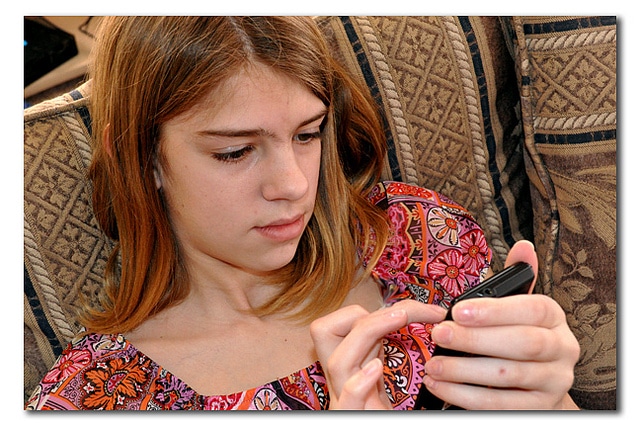
We’ve all read about cyberbullying and know it’s a bad thing. But do you know that recent surveys report that more than half of teens have been cyberbullying victims? This week’s GKIS article is an awesome start to an important conversation – what should parents do to help their kids avoid being the victim of cyberbullying?
THE BYSTANDER EFFECT
 The bystander effect refers to the phenomenon of how people are less likely to respond to a person in distress if others are present. The larger the number of bystanders, the less likely anybody will get involved. In other words, people tend to look to others for action instead of acting themselves. Another word for this psychological principle is the diffusion of responsibility,
The bystander effect refers to the phenomenon of how people are less likely to respond to a person in distress if others are present. The larger the number of bystanders, the less likely anybody will get involved. In other words, people tend to look to others for action instead of acting themselves. Another word for this psychological principle is the diffusion of responsibility,
The most common illustration of the bystander effect is the case of Catherine “Kitty” Geovese. Kitty was a young woman who was attacked and robbed in New York City in 1964. Although as many as 37 people witnessed the crime from their windows and heard Kitty screaming for help, nobody helped. One man, however, did yell, “Let that girl alone!” causing her attacker to flee and Kitty to crawl to her apartment.
Kitty’s attacker, Winston Moseley, then returned ten minutes later to kill her and steal $50. The attack took 30 minutes. A neighbor finally called the police after the final attack, resulting in an ambulance arriving 75 minutes after the first assault. This event suggests that if the neighbors weren’t aware of other onlookers, maybe somebody would have done more to help or intervened sooner.
How does this relate to cyberbullying?
For any single cyberbullying incident, there are various levels of participation. Many incidents involve an assessment of other online bystanders.
These include:
- The perpetrator who posts the harmful content (with varying levels of malicious intent)
- Those who encouragingly “like” or publicly comment on the post
- Those who encouragingly comment via backchannel chat
- Those who share or “favorite” the post
- Those who repeatedly bring the content back via online sharing or in the form of gossip or face-to-face bullying. (Repeat sharing sometimes goes on for years!)
- Those who view and “friend” or remain “friends” with the cyberbully online or offline
- Those who copy the cyberbully’s technique
- Those who view the cyberbullying incident without further action
- Those who view the cyberbullying incident and comment their protest via backchannel chat
- Those who view the cyberbullying incident and publicly comment their protest
- Those who flag the content as inappropriate or request Web mediation
- Those who request adult intervention through parents, academic staff, or law enforcement
Why do kids choose not to intervene?
So many possible responses! And it gets even more complicated from here. Not only are there many options to choose from about WHAT kind of response to make, but there are several reasons kids give WHY they make their decisions.
Robert Thornberg (2007) cites the following seven concepts associated with passive or non-intervention bystander behavior:
- Trivialization: The child doesn’t consider the incident serious (often because cyberbullying is so common children are desensitized).
- Dissociation: The child feels they are not involved in the situation or is not a friend of the cyberbully or the victim.
- Embarrassment association: The child doesn’t want to make the victim more embarrassed or doesn’t want to get embarrassed themselves (stage fright).
- Audience modeling: The child looks to bystanders for the social norm.
- Busy working priority: The child considers doing other things that are a higher priority than helping.
- Compliance with the competitive norm: The child considers social media etiquette or politeness more important than helping behavior.
- Responsibility transfer: The child ascribes more responsibility to other bystanders than themselves (e.g., online peers who are more involved with the bully or victim or online viewers with more authority).
What should a parent do?
Children need engaged parents to help them sort through these options to choose what’s right. That doesn’t mean parents should lecture about what’s right and what’s wrong, punish them, or take over. Kids need parents to help them work through complex problems to find the best solution. If the first choice doesn’t make a difference, try the second, the third, and so on. The important thing is to help each other through it.
What should parents encourage kids to do in a cyberbully situation?
- Assess their influence potential on the cyberbully. If they are allies at school, it may be worth it to reach out and ask the friend to remove the post or lay off the negativity.
- Assess their influence potential on the victim. Reaching out to help somebody who is hurting is a powerful maneuver. Even if the victim is not a friend, it helps to hear that you’re not alone.
- Reach out for expert support. Simply flagging the content online may be enough. Reaching out to offline authorities is also an option. Educate your child about the opportunity for anonymous reports and making a real difference.
- Never bully the bully or escalate the situation. Sometimes that’s just what the bully is looking for and then your child may become the victim.
- Do SOMETHING. Being observant, knowledgeable, and willing to think through your options is powerful.
And most importantly of all…parents please remember, what works in your adult world does not always work in your children’s worlds. Ultimately, they are the experts on what may make a positive difference, you are simply the facilitator.
I’m the mom psychologist who will help you GetKidsInternetSafe.
Onward to More Awesome Parenting,
Tracy S. Bennett, Ph.D.
Mom, Clinical Psychologist, CSUCI Adjunct Faculty
GetKidsInternetSafe.com
Works Cited:
Thornberg, Robert. “A Classmate in Distress: Schoolchildren as Bystanders and Their Reasons for How They Act.” Social Psychology of Education 10.1 (2007): 5-28. Web.
Photo Credits:
Tween Cell Phone Texting, Carissa Rogers. CC by 2.0Tiles by José Sáez, CC by 2.0
Working Word, CC by 2.0
J.K. Califf, CC by 2.0
Smartphone Teen by Pabak Sakar, CC by 2.0
Don't worry, we will never spam you.












